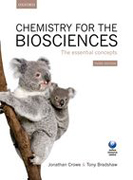
Chemistry for the Biosciences: The Essential Concepts
Crowe, Jonathan
Bradshaw, Tony
Focuses on the key chemical concepts which students of the biosciences need to understand, making the scope of the book directly relevant to the target audience. A conversational style and everyday analogies are used throughout, to help students relate unfamiliar concepts to situations and experiences that they are familiar with, and hence boost confidence in learning and understanding the subject. Opportunities for problem-solving, both in the book and online, encourage the reader to master key concepts and develop important numerical and data-handling skills. The assumption of limited prior knowledge makes it an ideal 'leveller', suitable for students with a range of backgrounds. Rich pedagogy makes learning as effective as possible: cross references encourage readers to make connections between different aspects of a broad subject; key points reinforce the messages that readers should grasp having read the text; marginal comments and footnotes provide extra clarifications; checklists of key concepts act as a useful revision tool; boxes throughout provide a deeper exploration of biological examples. Maths support is provided via the Maths Tool feature, going into detail about mathematical skills and concepts used in the text to enable students to supplement their mathematical knowledge. New to this edition New Chemical Toolkits explore some of the key skills and tools essential to understanding chemistry, and complement the existing Maths Tools. A new chapter, Metals in Biology, reviews the importance of metal ions in biological systems, to complement the coverage of organic compounds in other chapters. Enhanced and extended coverage of chemical reactions, including increased coverage of redox reactions and electrode potentials, and more emphasis on the carbonyl group and nucleophilic attack, and the reactions of carbonyl -containing compounds. Earlier introduction of ionization energy. Increased coverage of hydrogen bonding, resonance theory and enthalpy changes. Coverage of the mole and concentration is brought forward to chapter 5, giving students earlier exposure to these central concepts. Coverage of the structure of biological molecules now integrated into Chapter 10, Biological Macromolecules. Coverage of chemical reactions is brought forward to chapters 12 and 13, putting this topic back at the heart of the book. Coverage of electronegativity is brought earlier in chapter 3 as a lead into ionic and covalent bonding. The overview of hydrocarbons has been reorganized to make the discussion more comparative, and to highlight common features. New problem-solving questions, available via the book's ORC, help students to develop their data-handling skills. A greater number of self-check questions provide students with more opportunities for active learning while reading each chapter. Video screencasts online walk readers through a selection of examples and calculations to help them master key numerical and data-handling skills. Chemistry enables our eyes to detect the world around us; it determines whether something tastes sweet or sour; it helps genetic information pass accurately from one generation to the next. Ultimately, chemistry powers life itself. We don't need to dig very deep to answer the question: why do biologists need chemistry? Building on the success of the first two editions, Chemistry for the Biosciences introduces students to all the chemistry they need to understand the biological world. Renowned for its clear and straightforward explanations, the book uses everyday examples and analogies throughout to help students get to grips with chemical concepts, and presents them in context of biological systems wherever possible so they can see how chemistry relates to their wider studies. With topics drawn from organic, physical and inorganic chemistry, students will encounter a broad range of essential concepts to master. Chemistry for the Biosciences includes many learning features - both in print and online - to help students grasp these concepts as quickly and thoroughly as possible. From the self-check questions throughout each chapter to help consolidate learning, to the Chemical Toolkits and Maths Tools that help students explore terminology, methods, and numerical skills that may be unfamiliar, the book is written to be a true course companion for students on biological and biomedical science degrees - one that will help them not only remember the essentials, but really understand them, setting students up for success in their later studies. Chemistry for the Biosciences 3/e is supported by an extensive Online Resource Centre, featuring: For registered adopters: Figures from the book in electronic format, ready to download; A test bank of questions, with feedback linked to the text. Multiple-choice questions to aid exam preparation and revision; Full solutions to self-check questions; Data analysis and numerical practice worksheets; Mini-tutorials that walk students through a range of key concepts introduced in the book. Readership: Suitable for foundation level and first year undergraduate students taking a Chemistry module as part of a Biological, Biomedical or Life Sciences degree.
- ISBN: 978-0-19-966288-3
- Editorial: OXFORD UNIVERSITY PRESS.
- Encuadernacion: Rústica
- Páginas: 768
- Fecha Publicación: 30/01/2014
- Nº Volúmenes: 1
- Idioma:
